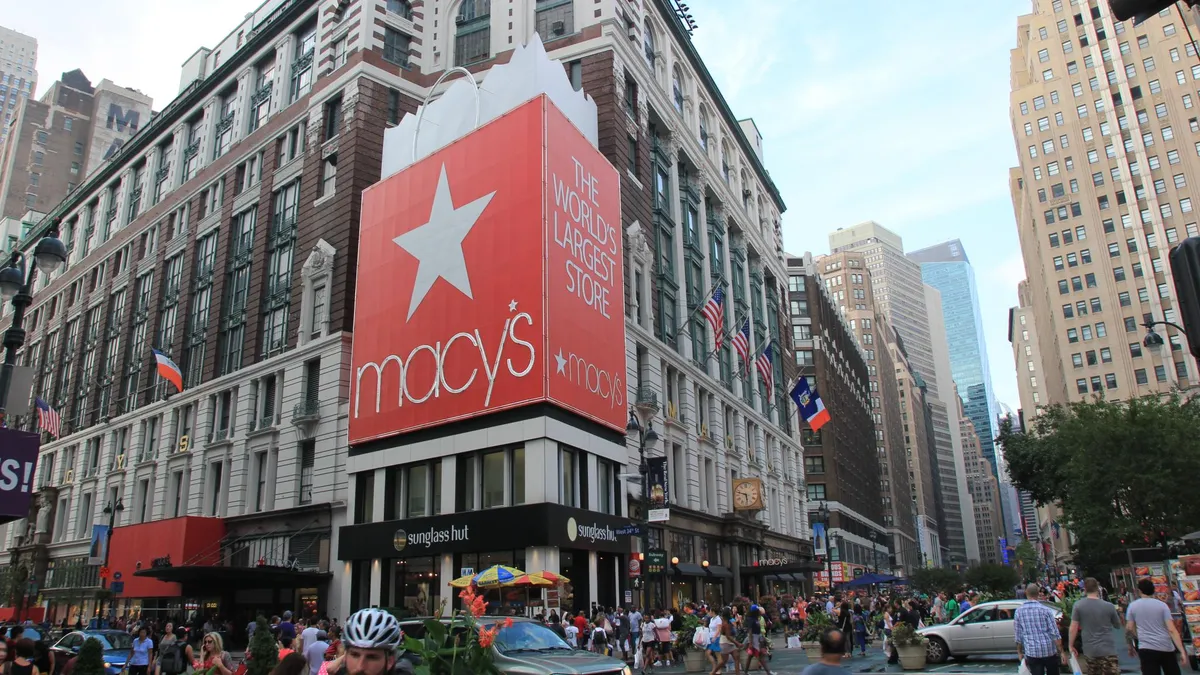Dive Brief:
- In the wake of a disastrous holiday shopping season, Macy’s announced Wednesday it could slash more than 10,000 jobs as it closes 68 stores and reorganizes its remaining locations.
- The closures, part of the approximately 100 closings Macy’s first announced last August, include 63 stores slated to cease operations this spring; two will close at midyear, and three others were sold (or are to be sold) and are being leased back, the department store retailer said. Another 30 Macy’s locations are on the chopping block over the next few years as leases or operating covenants wind down, or properties are sold.
- Macy’s estimates that 3,900 associates will be displaced as a result of the closures, but warns that additional measures — including a restructuring plan dedicated to eliminating layers of management in a push to cut costs and boost decision-making efficiencies — could signal the loss of roughly 6,200 additional positions.
Dive Insight:
It was anything but a happy holiday for Macy’s, the venerable retailer synonymous with the season thanks to the Hollywood perennial “Miracle on 34th Street” and its annual Thanksgiving Day parade, which it’s held since 1924. Macy’s announced Wednesday that comparable sales on an owned plus licensed basis declined by 2.1% in November and December 2016 combined, compared to the same period a year ago. On an owned basis, comparable sales fell by 2.7%.
In response, Macy’s said it expects its full-year sales guidance to come in at the lower end of the 2.5% to 3% decrease in comparable sales on an owned plus licensed basis it previously announced. The company now anticipates full-year 2016 diluted earnings per share in the range of $2.95 to $3.10, against previous guidance of $3.15 to $3.40.
“While our sales trend is consistent with the lower end of our guidance, we had anticipated sales would be stronger. We believe that our performance during the holiday season reflects the broader challenges facing much of the retail industry,” Macy’s CEO Terry Lundgren said in a statement, citing double-digit gains at both Macys.com and Bloomingdales.com as well as strong performances in apparel, fine jewelry, furniture and bedding, which were offset by ongoing weaknesses in handbags and watches.
The store closures and restructuring initiatives announced Wednesday will generate an estimated annual savings of about $550 million, Macy’s said, enabling the company to invest an additional $250 million in its digital efforts, store-related growth strategies, Bluemercury spas, off-price Macy’s Backstage outlets and its business in China.
Conlumino retail analyst Neil Saunders on Wednesday termed the moves a "necessary evil," but warned against using the proceeds on anything but shoring up its remaining business.
"It would be folly to simply use the gains to fund day to day operations or to return to shareholders," Saunders said in a note emailed to Retail Dive. "Macy’s needs a war-chest to revitalize its stronger stores, improve e-commerce, and develop new service and product offerings. If it fails to do this Macy’s runs the risk of having to shutter a further raft of stores down the line."
The question is how much more Macy’s can cut before virtually nothing recognizable remains. Many of the locations targeted for closure date back decades: The Macy’s location at Eastland Center in Harper Woods, MI opened in 1957, for example, while the downtown Minneapolis store, which spans more than 1.275 million square feet, has been in business since 1902.
Lee Peterson, executive vice president of brand, strategy and design at WD Partners, a global retail design firm, traces Macy’s struggles to the 2005 deal that brought those stores and hundreds of other locations together under the Macy’s umbrella.
“Heralded as a new beginning for the department store category, this merger in retrospect might have been the beginning of the end: The fateful day the department store category obliterated its greatest strengths,” Peterson recently wrote in a piece published by Retail Dive. “From that day forward, the strength of the corporate machine worked to consolidate regional brands under one banner, shedding brands from Marshall Field’s in Chicago to Lazarus in the Midwest. Loyal local shoppers rebelled. The dismantling of local institutions left shoppers feeling betrayed.”
But with so much shopping activity shifting from the offline world to the online realm, Macy’s faces few options but to reduce its physical footprint and focus on online retail. That’s easier said than done, however: Nick Egelanian, president of retail development consultants SiteWorks International, recently told Retail Dive that Macy's is “dreaming” if it thinks there’s salvation to be found online. “I’m telling you, there’s virtually no chance of that strategy succeeding,” he said, citing competition and cost pressures in the digital space.
Egelanian believes Macy’s must stay its current course, further reducing its bloated presence nationwide to a much more rational size, with major stores concentrated on the coasts. “There’s still a place for a department store like Macy’s,” Egelanian said. “It’s going to be a small chain, maybe a 150- to 250-store chain, and it’s going to carry stuff that’s relevant in today’s fashion, something that people can’t get at T.J. Maxx and H&M.”
The answer lies in a complete overhaul of stores and merchandise, Saunders said: "Revitalizing the business will not be easy. Shopping trends are firmly against Macy’s, and its brand, while not completely diminished, is most certainly tarnished. In our view, it needs to completely overhaul the experience to make stores easier to shop, more interesting to browse, and more relevant to today’s shopper. It also needs to develop a much more fulsome exclusive or own label offer to differentiate it from rivals."













